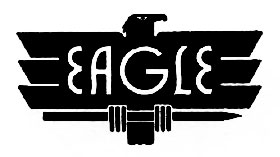Eagle Prestige c. 1939
Jim Mamoulides February 7, 2010, updated July 28, 2015
Matthew Greenberger contributed photos and details on the pen mechanism and restoration
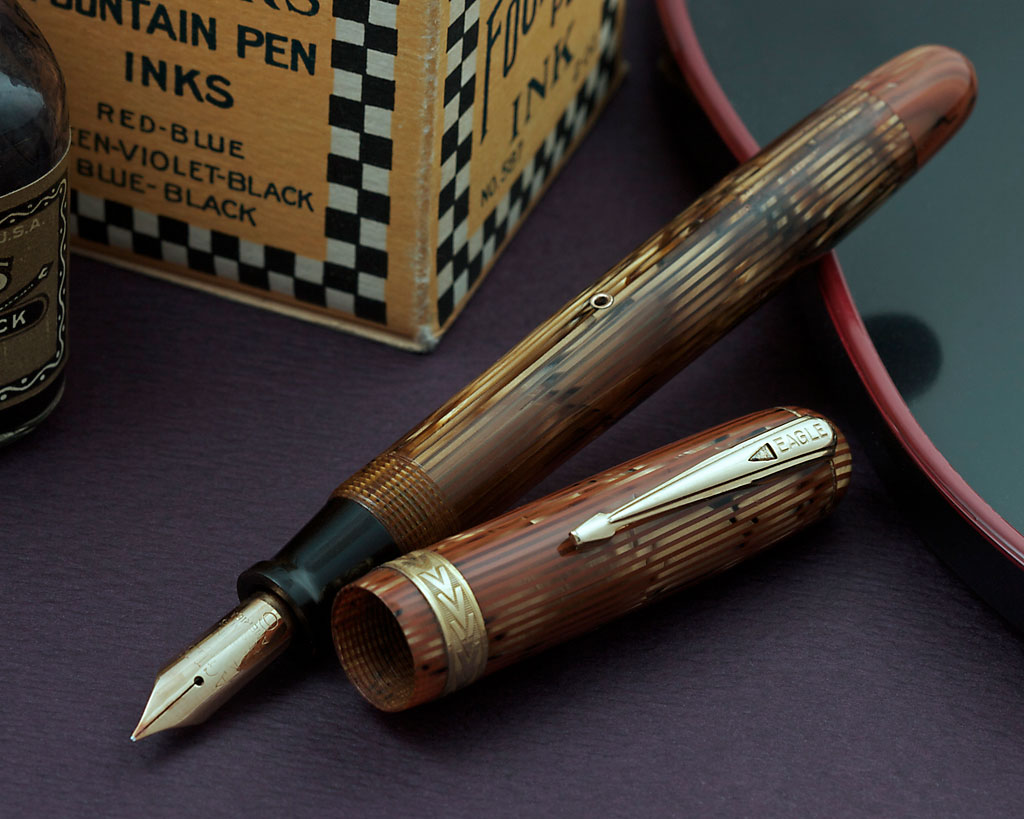 Eagle Prestige fountain pen in golden brown striped celluloid open. Note the hole in the center of the barrel.
Eagle Prestige fountain pen in golden brown striped celluloid open. Note the hole in the center of the barrel.
According to the article, "That Common Pencil & the Eagle Pencil Company," by Sterling Picard, mass produced pencil manufacturing began in the USA near the end of the American Civil War. Four companies rose as the largest manufacturers of pencils, names that are all still familiar today, the Eagle Pencil Company, Eberhard Faber, the American Lead Pencil Company, and Joseph Dixon Crucible Company. The Eagle Pencil Company was founded in New York, NY, in 1856 by Heinrich Berolzheimer, a German immigrant experienced in pencil making. Eagle was an innovative company, credited with making the first eraser tipped pencil in 1872.
This innovative outlook extended to other writing instruments, as well. Eagle patented a glass cartridge fountain pen on April 29, 1890, the first true cartridge pen, and Eagle offered them as all metal cylindrical and hexagonal cap and barrel models. The glass cartridges were sealed with wax until ready to use and the open end was mated with the base of the nib section, which was then pushed back into the barrel for writing. Eagle marketed a button filling pen in 1906 called the "Flash," indicating how quickly it filled. Eagle offered fountain pens for at least the next fifty years, many were high quality, but never sold as well as the big four, Parker, Sheaffer, Waterman and Conklin.
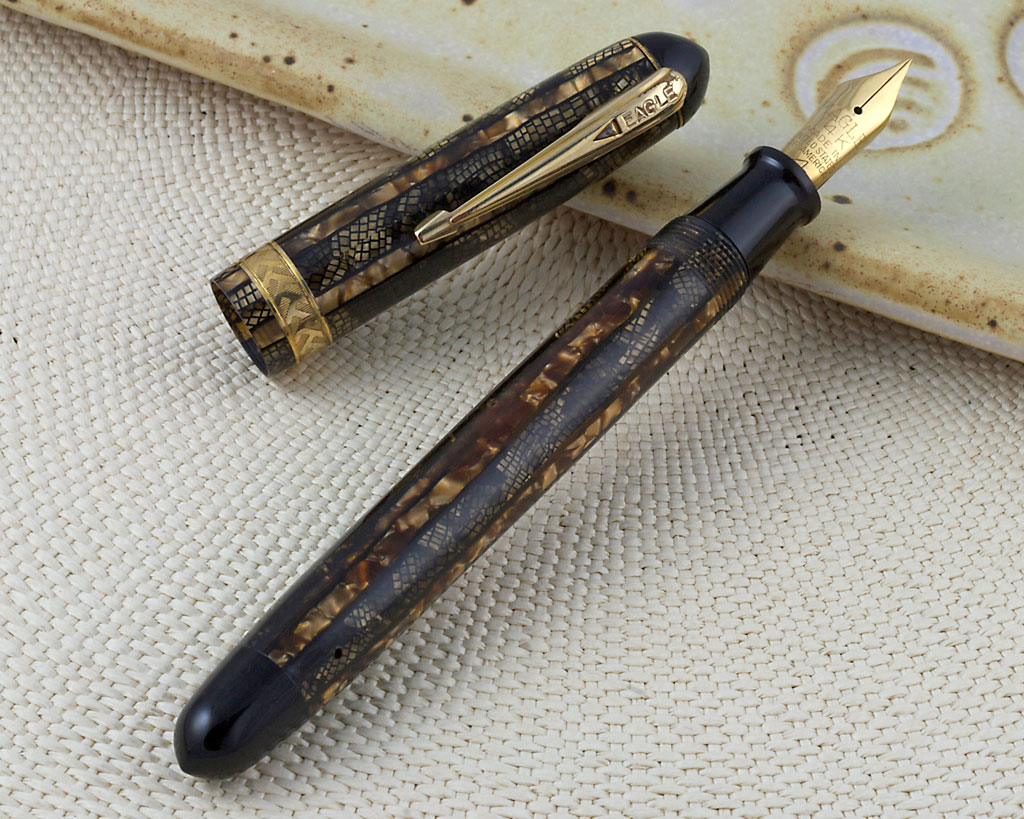 Eagle Prestige fountain pen in brown web and paneled celluloid open. Note the hole in the center and end of the barrel.
Eagle Prestige fountain pen in brown web and paneled celluloid open. Note the hole in the center and end of the barrel.
As there is very little primary material available on the Eagle Prestige fountain pen line, much of my research is limited to examining example pens and patent information, determining date information by their design, patent date, and feature elements. For example, Eagle marketed flat top lever-fill fountain pens in 1932 stamped "Eagle Prestige Made in USA" on the barrel, and I have seen some fitted with a nib, also stamped, "Eagle Prestige 14K Made In U.S.A." with the word prestige in script. This would indicate that Eagle saw the Prestige name as a brand and reused the brand name on this particular pen.
In the 1930s, Eagle, like most other fountain pen manufacturers, began to offer streamlined pens, a design trend started by Sheaffer with the Balance pen line in 1929. Eagle offered a a high quality lever actuated bulb filler streamlined pen in the late 1930s marketed using the Prestige brand. We don't see this particular pen offered in the Eagle Pencil Company 1937 catalog and because of later dated design patents, it's likely the pen was offered in 1938 or later. The design was an improvement on bulb fill fountain pens such as the Postal Reservoir Pen. Eagle submitted Benjamin W. Hanle's patent for the design on March 11, 1938 and patent 2,170,242 was awarded on August 22, 1939, which indicates that the Prestige was probably introduced in the 1938 to 1939 timeframe. I have no corresponding catalog or advertisement information to indicate the introduction or run of the line, and so few of these pens exist, that it is possible that they may have only been produced for a few years.
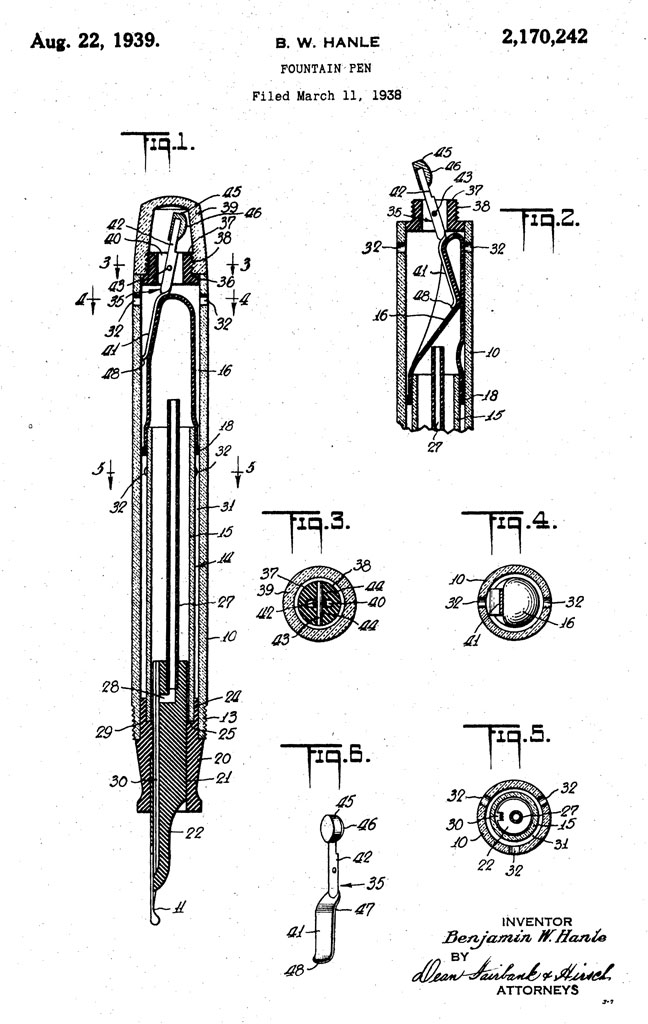 Eagle Patent US2170242 showing the paddle lever mechanism in the fountain pen
Eagle Patent US2170242 showing the paddle lever mechanism in the fountain pen
The patent describes the new pen as a vacuum type, using a rubber sac (bulb) and breather tube (called a vent tube in the patent) to create a vacuum in the ink chamber to fill the pen. The key element of the design is that it is based on a removable, transparent insulated self-contained filling unit inserted into into the barrel of the pen, where one end connects to the section and the other end has an ink sac. The filler unit is not flush with the sides of the barrel in the patent, with the claim that it insulates it from the barrel of the pen and avoids any heating that may occur by long term contact with warm hands that could result in the pen flooding.
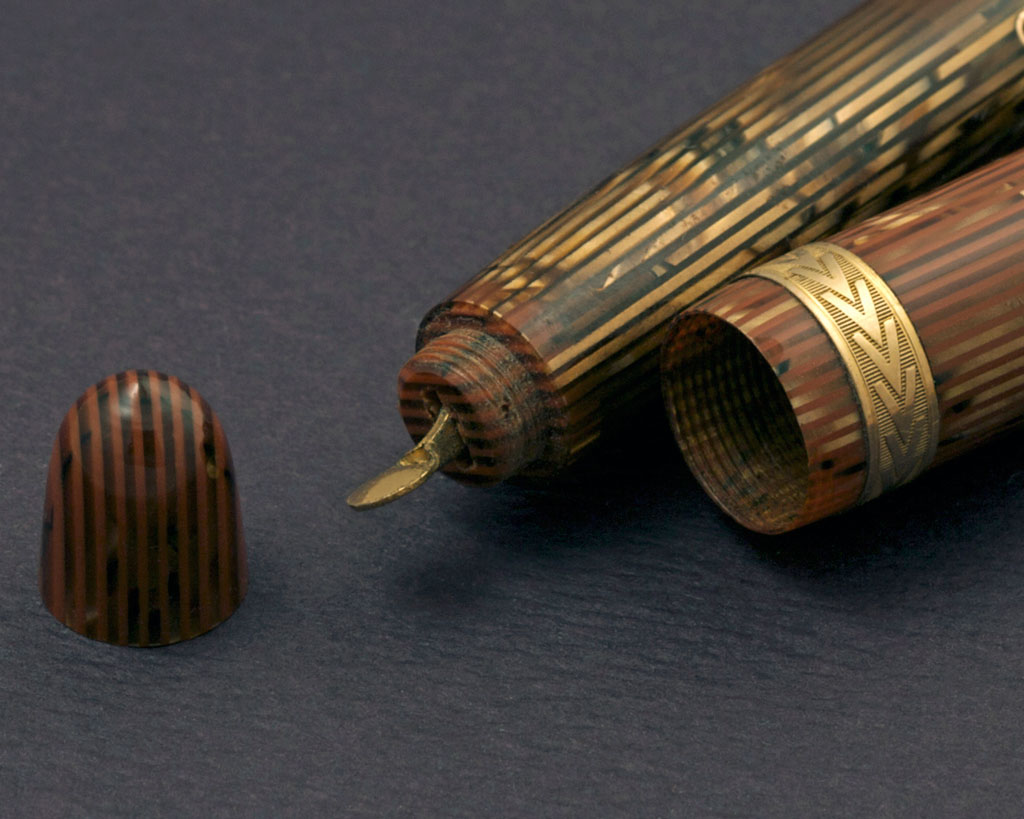 Eagle Prestige fountain pen in golden brown striped celluloid showing filling lever detail
Eagle Prestige fountain pen in golden brown striped celluloid showing filling lever detail
The long breather tube extends from the back of the nib section out to the opening at the barrel end. A short pressure bar clips into the inside of the back end of the barrel and is operated by a stubby lever that sticks out of the base of the barrel, covered by a blind cap when not in use. The pen is filled by repeated strokes on the lever, much like a Parker Vacumatic or Waterman Ink-Vue, and filling progress is gauged by looking through the translucent or transparent barrel into the ink chamber.
The patent goes on to describe how the barrel is drilled with holes to prevent pressure in the barrel from rising and also causing flooding. The actual pens have two sets of oppositely drilled holes, one pair about halfway and the other near the blind cap. Eagle stamped the barrel, "EAGLE PRESTIGE THE INSULATED PEN PATS PEND." to indicate the patent on the filling system.
 Eagle Prestige in golden brown striped celluloid open
Eagle Prestige in golden brown striped celluloid open
On the few examples of this pen that I have seen, the visible ink chamber is about 50-60% of the barrel length and extends from where the barrel meets the section, similar to many other vacuum and rubber sac type pens. A black version of the pen I have seen has a transparent upper barrel in this manner with a wavy line pattern, where ink level would be easy to track. I have seen two of the golden brown striped celluloid versions, a very similar material used by Conklin, and one with the brown web and marble striped celluloid, which I have also seen on a Conklin Chicago era Glider. I have seen an advertisement for a silver web and olive marbled striped celluloid Prestige, so there must have been several color choices. Each of the pens shown here have translucent celluloid barrels and ink level could be seen, but only with a bright backlight.
The "Visehold" clip is also derives from a patented two-piece washer clip design by Benjamin W. Hanle, awarded on November 26, 1935, indicating an arrowhead style design that must have annoyed Parker. In this design, the washer element of the clip has a triangular shaped tab that inserts into a slot on the clip itself, locking in with the triangle tip into a triangular shaped slot on the face of the clip, giving the impression of an inlay on the clip face. The Eagle Prestige clip is derivative of that design.
Finding the patent information on the filling system and clip was far easier than finding any advertisement or catalog information. I have not been able to find pricing, years offered, model numbers, finishes offered, so I can only indicate the actual examples that I have seen.
An inside look at the Prestige!
Section written by Matthew Greenberger
Matthew Greenberger contacted me after reading an earlier version of this article and wrote the following detailed examination of the Eagle Prestige mechanism and restoration. The pen's operation reminds him most of the Waterman Ink Vue, but with an inner barrel. Filling feels like filling an Ink Vue.
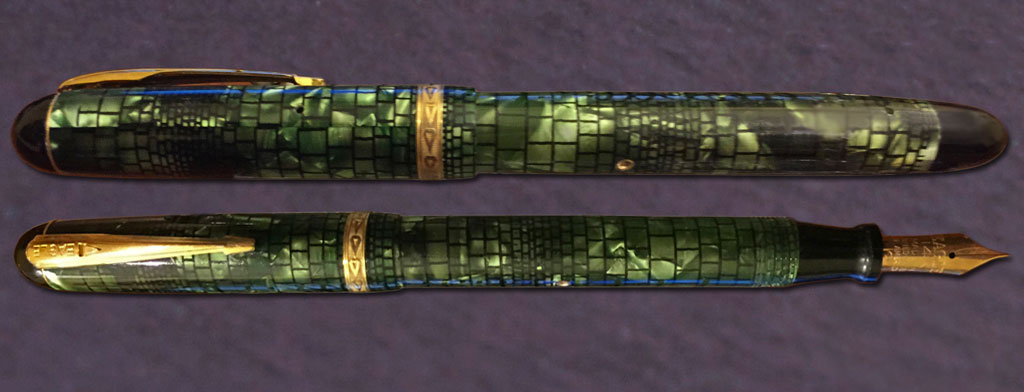 Eagle Prestige fountain pen in green brick celluloid open and closed - photo courtesy of Matthew Greenberger
Eagle Prestige fountain pen in green brick celluloid open and closed - photo courtesy of Matthew Greenberger
The section is threaded in the standard direction. It was not sealed in any way. The difficulty in removing the section is that the sac (more of an eyedropper bulb) was hard and adherent to the lever at the far end of the barrel. A look at the patent drawing shows how the lever indents the sac at rest, and shows why this step is a bit more difficult that a standard lever pen sac removal. The sac is attached to a clear inner barrel. Unlike a standard lever pen, the inner clear barrel will be twisting to break the sac, and there is little sac length between the inner barrel/ink reservoir and the lever. It appears that if one were to just unscrew the section, there could be some risk of breaking the inner barrel/ink reservoir. Careful use of low heat over time to warm the inner parts of the pen and gentle rocking the section back and forth, while unscrewing a bit more with each rotation was necessary to safely open the pen. It did not free up quickly.
 Backlit view of Eagle Prestige fountain pen barrel showing translucency - photo courtesy of Matthew Greenberger
Backlit view of Eagle Prestige fountain pen barrel showing translucency - photo courtesy of Matthew Greenberger
Once the inner barrel was removed, removal of the old dried sac was straightforward, taking care to avoid the centrally mounted lever which is easy to grab with the sac removal tools.
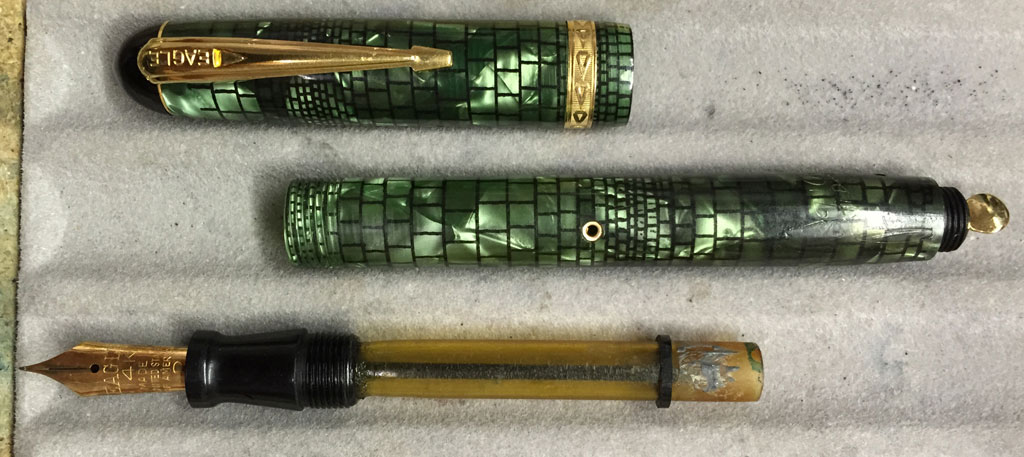 Exploded view of Eagle Prestige fountain pen in green brick celluloid with old sac removed - photo courtesy of Matthew Greenberger
Exploded view of Eagle Prestige fountain pen in green brick celluloid with old sac removed - photo courtesy of Matthew Greenberger
This example appeared to have a lot of adhesive holding the clear inner barrel to the section. Matthew did not want to risk removing it to clean the inner barrel/ink reservoir, section and nib. Ultrasonic bath and flushing with a bulb did the trick, but repeated treatments were needed. A long hollow rod could be used to knock out the feed, but again, with some risk to the ink reservoir tube.
The new sac was sized using a depth probe (wooden chopstick) and marking the length, then using that as a gauge to cut the new sac. Matthew chose to overlap the inner barrel to the same extent as the original sac, ensuring that the final length was only about 1 mm shorter than the mark on the depth gauge.
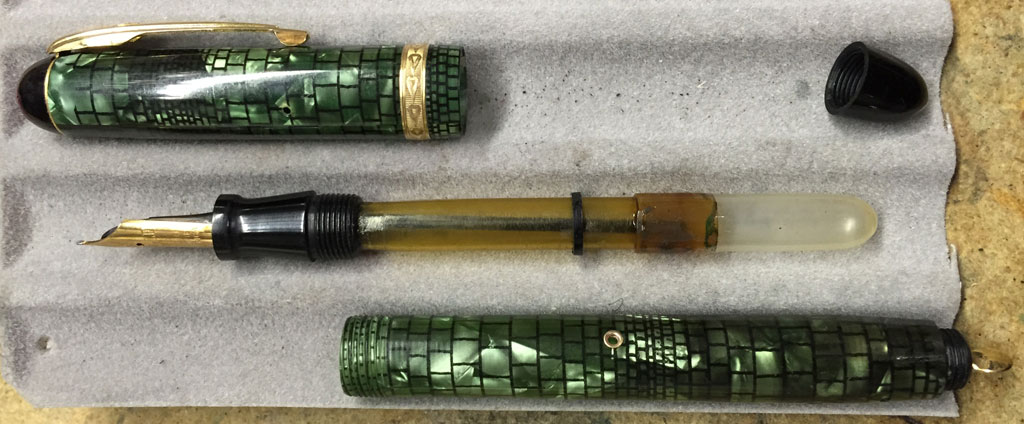 Exploded view of Eagle Prestige fountain pen in green brick celluloid with new clear sac - photo courtesy of Matthew Greenberger
Exploded view of Eagle Prestige fountain pen in green brick celluloid with new clear sac - photo courtesy of Matthew Greenberger
A lot of talc is recommended on the outside of the sac, as it will be turned multiple rotations inside against the inner lever. A smaller sac could make this easier. The original sac removed was about the same diameter as the inner barrel/ink reservoir.
The inner spacer ring hung up on the metal grommets for the air vent holes. It was decided to leave this alone. Using a small dab of shellac to hold it closer to the sac might be helpful, and it would not be visible as that end of the barrel is opaque. This is the correct location per the patent.
With a lot of talc, it became more apparent that the black spacer ring on the clear inner barrel has two flat spots opposite of each other to facilitate getting it up past the vent hole grommets mid barrel.
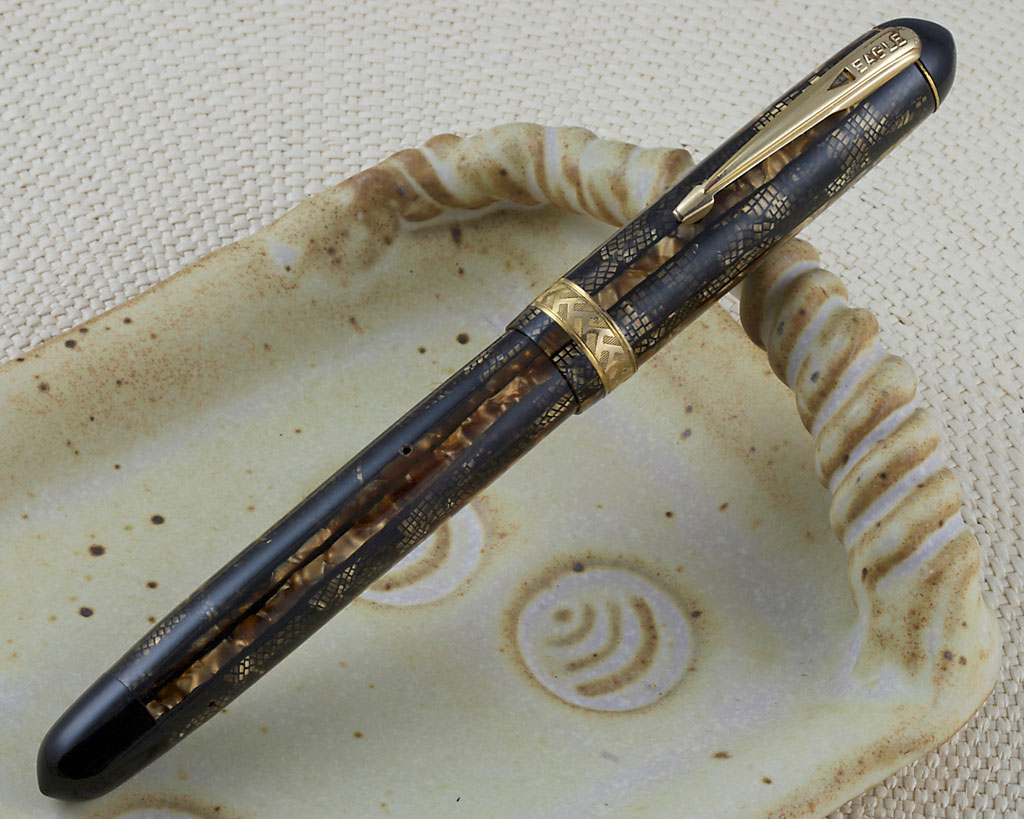 Eagle Prestige fountain pen in brown web and marble paneled celluloid closed
Eagle Prestige fountain pen in brown web and marble paneled celluloid closed
Identification guide and features:
Marketed c1939, based on patent application. Identification guide based on observed examples. There are certain variations that suggest possible multiple production runs, such as three different cap bands, two nib types, and the barrel breather hole with or without grommets.
- Celluloid cap and barrel
- Observed colors (descriptive names as actual names not known): solid black with wavy line pattern transparent barrel, brown web and marble paneled, golden brown stripe, silver web, green brick, and olive marbled striped
- Depending on barrel materials, cap top and lever cover may be black or made from matching body celluloid
- Barrel imprinted Eagle Prestige
- Gold plated cap band in three observed patterns (descriptive names as actual names not known): repeating arrows, repeating angled T pattern, repeating teardrop with triangle cutout
- All cap bands have a top and bottom edge band and vertical lines as background
- Gold plated patented design clip with triangle tab and stamped "EAGLE"
- 14 karat gold number 4 or number 6 nib
- Unknown selection of nib grades, fine and medium observed
- About 5 3/16 inches long capped and 6 3/16 inches posted
Performance
The Eagle Prestige brown web and marble striped celluloid shown here is a full length, yet very light weight pen, weighing 0.5 ounce and being 5 3/16 inches long with the cap on and a long 6 3/16 inches with the cap posted on the end of the barrel. The pen does not post very deeply or securely so if I were to use it, I would leave the cap off to the side. It's fine in the hand with the cap not posted.
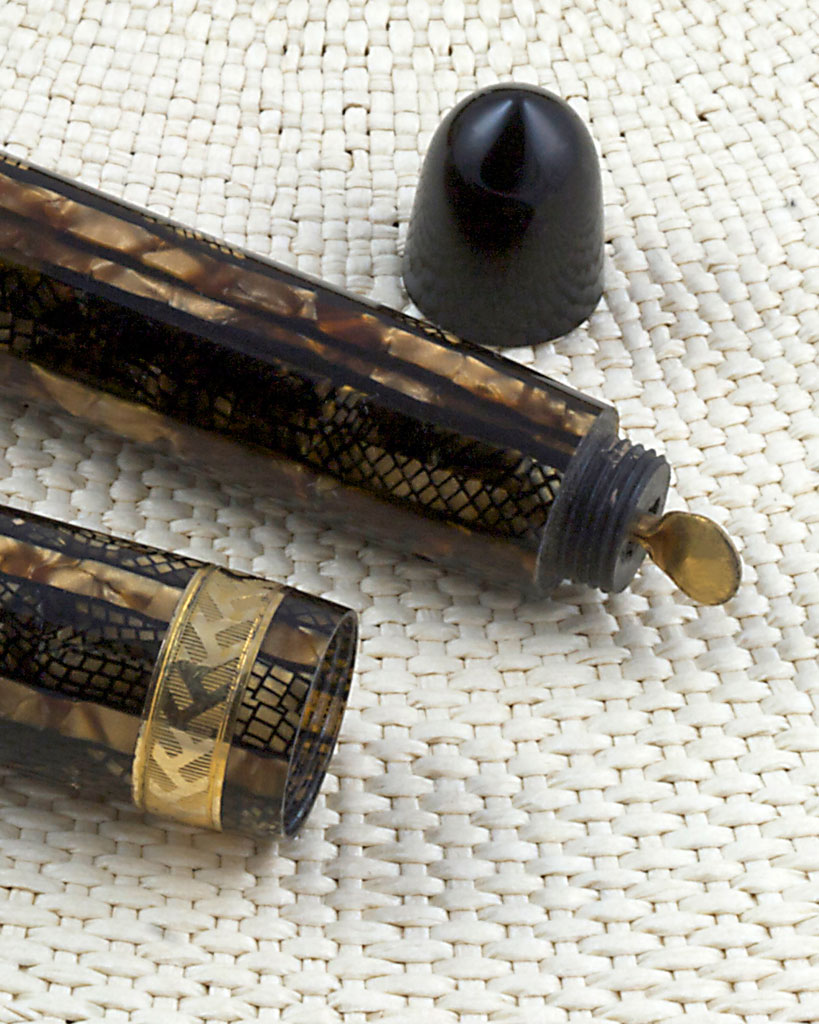 Eagle Prestige fountain pen in brown web and marble striped celluloid showing filling lever detail
Eagle Prestige fountain pen in brown web and marble striped celluloid showing filling lever detail
This is the only Eagle Prestige I have seen with a number 4 nib and its cap band design is different than all the others I have seen, which have a repeating arrowhead design. The golden brown striped celluloid version was photographed quite a long time ago, and I no longer have measurements on the pen, but note that it and all the other Eagle Prestige pens have number 6 nibs. It may be, as with the Conklin Glider, that there are two sizes of Eagle Prestige, with the only difference being the girth of the cap and barrel, and thus the two nib sizes.
As neither of these two pens were mine, I did not fill them, as I did not want to contribute to any ink staining in the ink reservoir. Both had been restored and operating the lever unit dry indicates that it would be very similar to a Waterman Ink-Vue or Parker Vacumatic in use. If you have used a bulb filler, like the Postal Reservoir Pen or any of the many copies made in the 1930s, you would immediately know how this pen will work. Eagle just added the stubby lever.
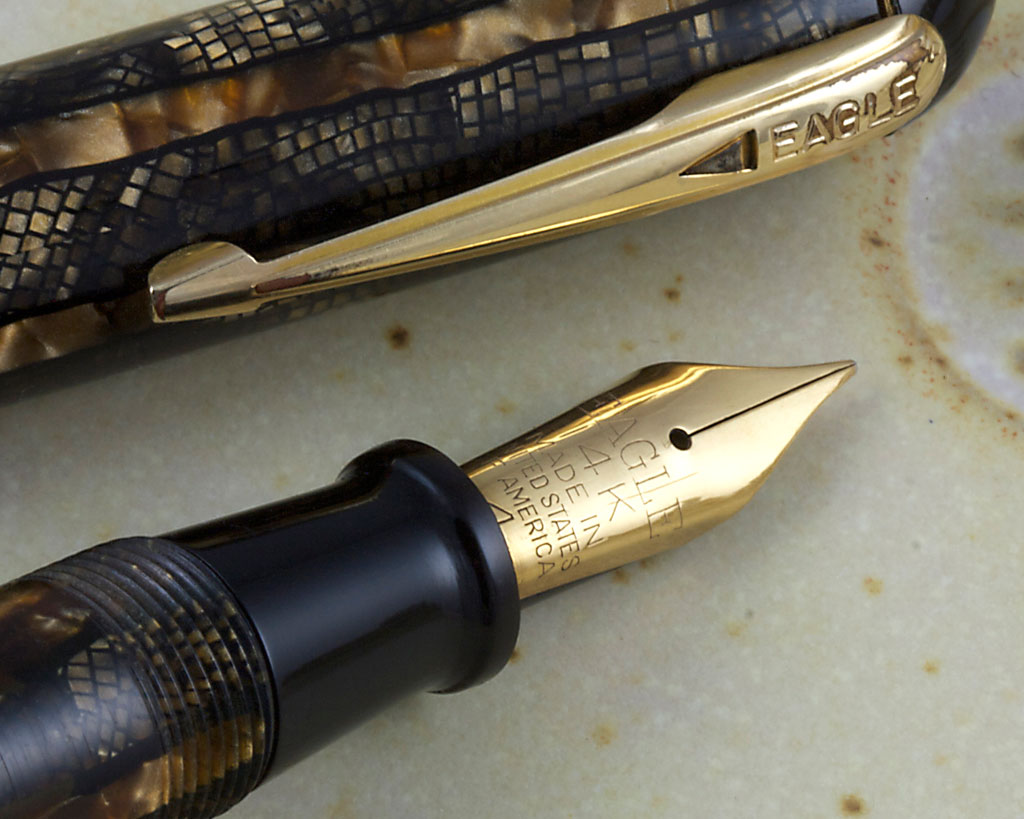 Eagle Prestige fountain pen in brown web and marble striped celluloid cap and nib detail. Note the triangle section on the clip.
Eagle Prestige fountain pen in brown web and marble striped celluloid cap and nib detail. Note the triangle section on the clip.
The 14 karat gold nib is large and impressive, stamped, "EAGLE 14K MADE IN UNITED STATES OF AMERICA" with the nib size number stamped below. Writing dry, the nib is quite smooth and firm and appears to be an extra fine or fine. I am sure, having used other Eagle models, that the nibs are nice quality and write well.
Collectors who have Eagle Prestige pens and know how they work prize them for being not only unusual in design but also uncommon in availability. Collecting these pens would present a challenge, as they are not common and command a higher price than a typical second tier brand. This is justified as the pens are very well made and Eagle put the effort into a patented design rather than create a simple "me, too" pen. Eagle also chose nice celluloids for these pens, which would make collecting them a treat.
Acknowledgement
Thanks to Matthew Greenberger for providing photos of his Eagle Prestige fountain pen in green brick celluloid and for his detailed write-up on how the pen is assembled and restored.
References
That Common Pencil & the Eagle Pencil Company," by Sterling Picard, Lion and Pen, June 26, 2007
Fountain Pens: The Complete Guide To Repair & Restoration, by Frank Dubiel, © Copyright 2002 by Frank Dubiel
Berol, Wikipedia
Eagle Pencil Company 1932 Catalog
Eagle Pencil Company 1937 Catalog
Eagle Flash advertisement, Munsey's Magazine, attributed 1906
Writing instrument patent US 2170242 A, Eagle Pencil Company, published on August 22, 1939
Writing instrument patent US 2022416 A, Eagle Pencil Company, published on November 26, 1935
Writing instrument patent US 1926852 A, Eagle Pencil Company, published on September 12, 1933
Writing instrument patent US 426758 A, Eagle Pencil Company, published on April 29, 1890
Interact
Comments on this article may be sent to the author, Jim Mamoulides


